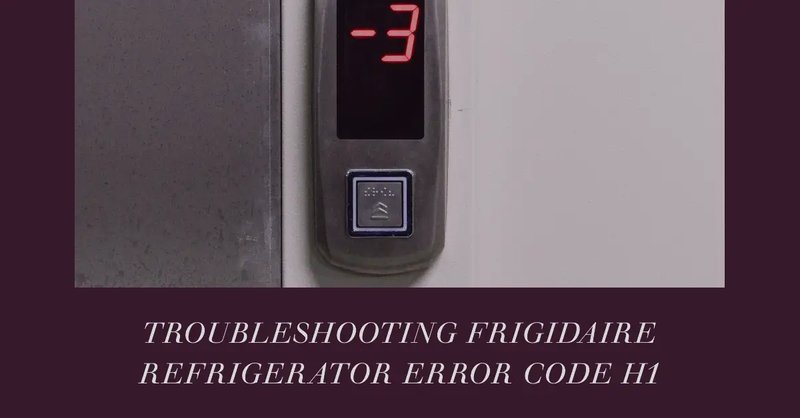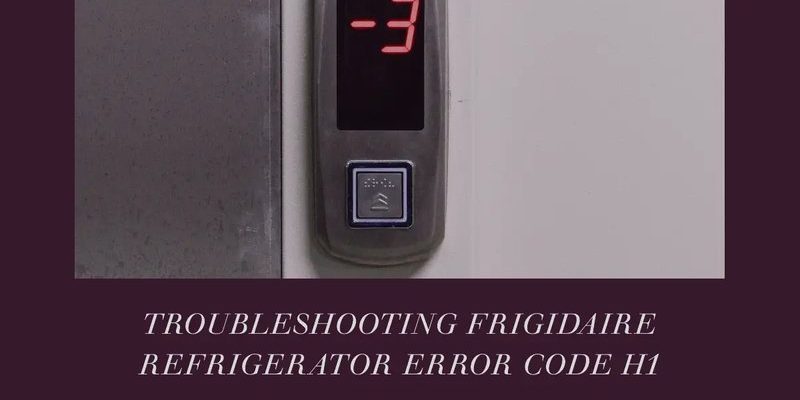
The “F1” error code in your Frigidaire refrigerator is a signal, much like a smoke alarm beeping when there’s smoke. It’s an alert that something isn’t quite right under the hood. Think of it as your fridge’s way of waving a tiny white flag, asking for some attention. Typically, this error indicates a problem with the refrigerator’s control board, which is like the brain that manages all its operations. If the control board malfunctions, it can impact everything from the cooling cycle to the ice maker’s operation. Understanding this can be a bit daunting, but don’t worry, we’re here to help you navigate through what to do next.
Understanding the “F1” Error Code on Your Fridge
When the “F1” error code appears, it’s kind of like getting a warning light on your car dashboard. It suggests there’s a hiccup somewhere in the system. Specifically, for Frigidaire refrigerators, this code is commonly associated with issues in the control board – the central hub that controls all major functions like temperature settings, fan speeds, and even the defrost cycle. You might be wondering, “Why does this happen in the first place?” Well, much like how a computer might freeze or a smartphone might glitch, your refrigerator’s control board can experience electronic faults or software bugs over time.
Imagine the control board as the conductor of an orchestra, ensuring each component plays in harmony. If the conductor misses a beat, the entire performance is affected. Similarly, any miscue in the control board can throw your refrigerator’s operations out of whack, leading to an F1 code. While the error code gives you some information, it doesn’t pinpoint the exact issue or part affected, which is why it can be tricky to diagnose on your own.
It’s essential to remember that while error codes like F1 may seem intimidating, they’re primarily meant to guide you or a service professional to the source of the problem. However, before calling in the cavalry, there are a few things you might want to try at home first, just to see if you can resolve the issue without professional help.
Troubleshooting the F1 Error: Steps You Can Take
Before you rush to dial a technician, there are some simple steps you can take to see if the problem can be easily remedied. Think of these steps as your first-aid kit for minor refrigerator ailments. First off, try performing a reset of your refrigerator. This is akin to rebooting your computer when it acts up. You can do this by unplugging the refrigerator from the wall outlet for about 5-10 minutes. Then, plug it back in and see if the error code disappears.
Another step involves checking the connections on the control board. If you’re comfortable, you can safely remove the back panel of the fridge to access the control board. Sometimes, simply ensuring that all the wires and connectors are firmly in place can solve the issue. It’s like making sure the cables to your TV are plugged in correctly when the screen goes blank.
If these steps don’t clear the F1 error, it might be time to consider the possibility that the control board itself could be faulty and in need of a replacement. Again, this doesn’t necessarily mean you’re out of options, but it does suggest that reaching out for professional help could be the next best step.
When to Call a Technician
So, when should you consider calling in a professional technician? If the error persists after you’ve tried the basic troubleshooting steps, it’s probably a good idea to reach out. A technician is like a doctor for your fridge – they have the tools and expertise to diagnose the problem accurately and fix it reliably. Especially when dealing with electrical components, having a trained professional can prevent further damage and ensure safety.
Another situation where a technician’s expertise becomes invaluable is if the control board needs replacement. This task requires specific skills to ensure the new board is compatible and correctly installed. Attempting a DIY fix without the proper knowledge can lead to more issues, much like trying to change your car’s engine without the right tools or experience.
Calling a technician also means you’re not just treating a symptom but addressing the root cause of the problem. They can provide guidance on preventing future issues, such as ensuring your refrigerator is not overburdened with food, which can strain the cooling system. Moreover, they can check other key components that might be on the brink of failure, saving you headaches down the road.
Preventative Measures and Maintenance Tips
To avoid seeing the F1 error code—or any error code, for that matter—in the future, adopting a few simple maintenance habits can go a long way. Think of these tips as a health check-up for your fridge. Regularly cleaning the condenser coils can prevent the compressor from overheating, which is a common cause of control board failures. Dust and debris build-up can impede heat dissipation, much like when your laptop overheats on a warm day.
Additionally, ensuring that the refrigerator door seals are airtight can keep the cold air locked inside, reducing strain on the compressor. Imagine leaving a window open while trying to cool a room—inefficient and costly. Checking these seals and cleaning them regularly can enhance your fridge’s efficiency.
Lastly, avoid overstuffing your refrigerator. It can cause uneven cooling and strain various components. Keeping your fridge organized can not only maximize space but also ensure that air circulates properly, keeping everything at the right temperature.
By following these maintenance tips, you can help prevent error codes and extend the lifespan of your refrigerator. But remember, if the F1 code pops up and troubleshooting doesn’t help, a professional’s touch might be just what’s needed to get things back to normal.
